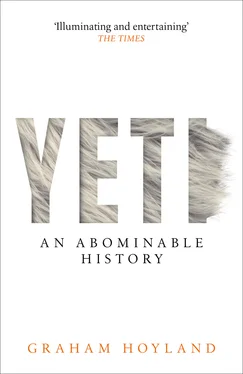Tilman was certainly the greatest explorer and adventurer of the twentieth century. He won the Royal Geographical Society’s Founder’s Medal in 1952, but his career also encompassed military service in both world wars: he won the Military Cross twice in the first conflict and led a band of underground Albanian Resistance fighters for the British Special Services in the Second World War. In between the wars, he worked as a planter in Africa where he met his long-term climbing companion Eric Shipton. He was the first to climb the Indian mountain Nanda Devi, the highest peak then climbed, and he led the 1938 Everest expedition. He evolved a lightweight, living-off-the-land style of exploration which is now much admired by other adventurers but which was difficult for his companions, who were expected to eat lentils and pemmican at high altitude. After the Second World War, he undertook a little spying in the Karakoram and then embarked on a second career as a deep-sea sailing explorer in a series of ancient Bristol pilot cutters, two of which he sank in unexpected encounters with the land. After a lifetime of inventive expeditions to high mountains and cold seas, he and his crew eventually disappeared on an Antarctic voyage in his 80th year, a mystery to the end.
Tilman was something of an enigma. Clearly traumatised by his experiences as a 17-year-old in the First World War, he appeared to grow a crust over his emotions which made him appear indifferent to his own or others’ sufferings. He was gruff and taciturn, but not irritable. In appearance he was stocky, wore a moustache and smoked a pipe. He never married and appeared to prefer the company of men, but didn’t show any interest in either sex. He seemed to exert an iron grip on his emotions, and one wonders what would have tumbled out had he ever let go. The key to Bill Tilman seems to be what happened to him during the most terrible conflict the world has ever seen. Coming out of it aged just twenty, he asked the question: ‘Why was I spared when so many of the best of my companions were not?’ Like Howard Somervell who asked just the same question, he seemed to suffer from that paradoxical complaint: survivor’s guilt. In the end, Tilman seemed happiest on the open road: ‘I felt uncommonly happy at trekking once more behind a string of mules with their bright headbands, gaudy red wool tassels, and jingling bells, over a road and country new to me with the promise of sixteen such days ahead. I felt I could go on like this for ever, that life had little better to offer than to march day after day in an unknown country to an unattainable goal.’ 8
Being Tilman, though, he immediately undermined the conceit by self-deprecation: ‘The morning was well advanced and it was uncommonly hot, so that my thoughts underwent a gradual change. Far from wishing the march to go on for ever, I did not care how soon it would be over. I did not care if it was my last.’
His enduring achievement is his series of fourteen travel books, some of them classics of the genre. He is the master of a good travel tale, with a self-deprecating black humour which is sometimes misunderstood.
Turning to the subject of the yeti, or Abominable Snowman, firstly we have to concede that Tilman had an ambivalent attitude to science. As one of his biographers, J. R. L. Anderson, pointed out, 9he held that travel and mountain climbing should be ends in themselves and science should not be allowed to compromise the adventure. He himself wrote: ‘The idea of sending a scientific expedition to Everest is really deplorable; there could be no worse mixture of objectives.’ 10In this he was controversial, as some might say that the only reason Everest was eventually climbed (on the ninth attempt, in 1953) was by Griffith Pugh’s application of science in the form of oxygen equipment, diet and clothing. Adventurers of the hardy variety would retort that Everest was only climbed properly in an ethical way in 1978 by Reinhold Messner and Peter Habler when they succeeded without using supplementary oxygen.
Despite this, Tilman was a careful observer, taking great trouble to check geographical locations and work out heights on his spying mission in Chitral: ‘We used an aneroid barometer and at specially important points took boiling point thermometer readings. As there were no basic stations sufficiently near for the reduction of the barometer to sea level, the barometrical readings taken during three days before leaving Urumchi were used as a check. For this period a correct mean height of the barometer was ascertained by using the observations made by Strowkowski over a period of three years in Urumchi.’ 11
A sailor would know just how proficient Tilman was at celestial navigation, finding himself around the oceans of the world armed only with paper charts, compass, sextant and a copy of Lecky’s Wrinkles In Practical Navigation: ‘The amateur sailor, or haphazard navigator, should ponder a remark of the editor of the new edition of Lecky’s Wrinkles: “There is nothing more distressing than running ashore, unless it be a doubt as to which continent that shore belongs.”’ 12
However, it cannot be denied that Tilman sometimes derided science and scientists in his books, and I suspect that, like his friend Eric Shipton, he had a sense of humour and may have played fast and loose with the truth when it came to the Abominable Snowman.

On Mount Everest in 1938, Tilman’s team included Eric Shipton and Frank Smythe: the very two men accused by Ernst Schäfer of using yeti footprints to raise expedition funding. All three of these men had seen strange footprints in the Himalayas. One can imagine the campfire stories about the Abominable Snowman. Rongbuk is an eerie valley at the best of times; I have walked alone there at night with the ghosts of Mallory and Irvine at my back and can imagine that the shifting shadows beyond the firelight might have caused the odd shiver of fear.
These same three climbers had just had a minor spat in the newspapers before the expedition. Smythe had reported his find of what he insisted were bear tracks in The Times of 10 November 1937, perhaps with a view to some helpful pre-publicity for his next book; and Tilman, under the pseudonym of Balu (the bear), had put up a defence of the Abominable Snowman in the letters page on 13 November where he wrote: ‘Mr Smythe’s article, if it was an attempt to abolish that venerable institution, the “Yeti”, was hardly worth the paper on which it was written.’
This was nicely calculated to wind up the irascible Smythe (note that this was one of the first public uses of the term ‘yeti’ instead of Abominable Snowman). Shipton, also writing pseudonymously (as The Foreign Sportsman, one of the Sherpa’s nicknames), had given his own first-hand experience of footprints in the snow, and supported Balu. He wrote: ‘Balu’s contribution to the discussion was welcome. His spirited defence of the Abominable Snowman wilting under the combined attack of Mr Smythe and the Zoological Society reminded me of Kipling’s lines: “Horrible, hairy, human, with paws like hands in prayer, making his supplication rose Adam-Zad the bear.”’
In short, Tilman and Shipton were having a bit of fun taking the mickey out of the presumptuous Frank Smythe and a bunch of self-important scientists. This was altogether more amusing than the annual ‘first cuckoo of spring’ type of letters to The Times , and this controversy between Himalayan rivals, I suggest, may have provided the spark for what I think was the biggest yeti hoax of the century. (But that was to come much later, in 1951, after Smythe was dead.)
Tilman loved the Abominable Snowman story and had had first-hand experience of it. This is what he reported in his Times letter. He told the 1938 Everest party how in the previous year, during his great journey of exploration across the Karakoram with Eric Shipton, he and two Sherpas came across the footprints of a strange animal:
Читать дальше












